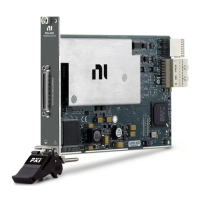© National Instruments | 6-11
X Series User Manual
Routing DI Pause Trigger Signal to an Output Terminal
You can route DI Pause Trigger out to any RTSI <0..7>, PFI <0..15>, PXI_STAR, or
PXIe_DSTARC terminal.
Note Pause triggers are only sensitive to the level of the source, not the edge.
Digital Output Data Generation Methods
When performing a digital waveform operation, you either can perform software-timed or
hardware-timed generations.
Software-Timed Generations
With a software-timed generation, software controls the rate at which data is generated. Software
sends a separate command to the hardware to initiate each update. In NI-DAQmx,
software-timed generations are referred to as on-demand timing. Software-timed generations are
also referred to as immediate or static operations. They are typically used for writing a single
value out, such as a constant digital value.
Hardware-Timed Generations
With a hardware-timed generation, a digital hardware signal controls the rate of the generation.
This signal can be generated internally on your device or provided externally.
Hardware-timed generations have several advantages over software-timed generations:
• The time between samples can be much shorter.
• The timing between samples can be deterministic.
• Hardware-timed acquisitions can use hardware triggering.
Hardware-timed operations can be buffered or hardware-timed single point (HWTSP). A buffer
is a temporary storage in computer memory for to-be-transferred samples.
• Hardware-timed single point (HWTSP)—Typically, HWTSP operations are used to
write single samples at known time intervals. While buffered operations are optimized for
high throughput, HWTSP operations are optimized for low latency and low jitter. In
addition, HWTSP can notify software if it falls behind hardware. These features make
HWTSP ideal for real time control applications. HWTSP operations, in conjunction with
the wait for next sample clock function, provide tight synchronization between the software
layer and the hardware layer. Refer to the NI-DAQmx Hardware-Timed Single Point
Lateness Checking document for more information. To access this document, go to
ni.com/info and enter the Info Code daqhwtsp.
Note (NI USB-634
x/635x/636x Devices) USB X Series devices do not support
hardware-timed single point (HWTSP) operations.

